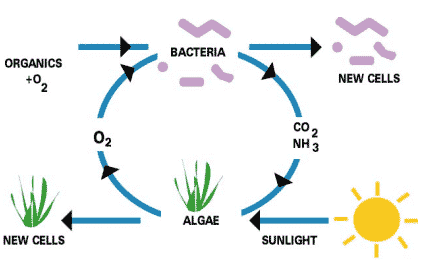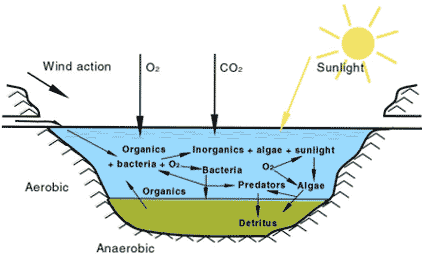

Waste Stabilization Ponds
HISTORY OF WASTE STABILIZATION PONDS
Wastewater lagoons have been used as a process for wastewater treatment for centuries. In the 1920’s artificial ponds were designed and constructed to receive and stabilize wastewater. By 1950, the use of ponds had become recognized as an economical wastewater treatment method for small towns and industries. As of 1980, approximately 7,000 waste stabilization ponds (WSPs) were in use in the U.S. Today, one third of all secondary wastewater treatment facilities include a pond system of one type or another.
WHAT IS WSP?
Waste Stabilization Ponds (WSPs), often referred to as oxidation ponds or lagoons, are holding basins used for secondary wastewater treatment where decomposition of organic matter is taking place naturally. A WSP is a relatively shallow body of wastewater contained in an earthen manmade basin into which wastewater flows and after certain retention time a well-treated effluent flows out. Retention time is the time taken by the effluent to flow from the inlet to the outlet of the basin.
The activity in the WSPs is a complex symbiosis of bacteria and algae, which stabilizes the waste and reduces pathogens. The algae produce oxygen during photosynthesis by utilizing carbondioxide and solar energy derived from sun light. The bacteria utilize oxygen for the biological process to convert the organic content of the effluent to more stable and less offensive forms and release carbondioxide. This interdependends of algay and bacteria is known as mutualistic or algae – bacteria simbiosis. They can be used alone or in combination with other treatment processes.
TYPES AND FUNCTIONS OF WSPs
WSPs are of two types;
a) single pond or Primary facultative pond and
b) multi-cell pond system. 1 Single Pond or Primary Facultative Lagoon
In general, the wastewater in facultative lagoon naturally settles into three fairly distinct layers or zones. Different conditions exist in each zone, and wastewater treatment takes place in all three. the single pond or facultative pond. The top layer in a facultative lagoon is called the aerobic zone, because the majority of oxygen is present there. The depth of the aerobic zone is depends on loading, climate, amount of sunlight and wind, and quantity of algae presnet in the water. The wastewater in this part of the lagoon receives oxygen from air, from algae, and from the agitation of the water surface from wind and rain. This zone also serves as a barrier for the odors from gases produced by the treatment processes occurring in the lower layers.
The anaerobic zone is the layer at the very bottom of the lagoon where no oxygen is present. This area includes a layer of sludge, which forms from the solids that settle out of the wastewater. Here, wastewater is treated by anaerobic bacteria, microscopic organisms, such as certain protozoa, and sludge worms, all of which thrive in anaerobic conditions
The middle layer called facultative zone, includes the facultative, intermediate, or aerobic- anaerobic zone. Both aerobic and anaerobic conditions exist in this layer in varying degrees. Depending on the specific conditions in any given part of this zone, different types of bacteria and other organisms are present that contribute to wastewater treatment.
Throughout facultative lagoons, physical, biological, and chemical processes take place that result in wastewater treatment. Many of these processes are interdependent. For example, on the surface, wind and sunlight play important roles. Surface agitation of any kind adds oxygen to the wastewater. For this reason, facultative lagoons are designed to make the best use of wind in the area. The amount of wind the lagoon receives is not only important for the oxygen it contributes, but also because it affects the overall hydraulic flow pattern of the wastewater inside the lagoon, which is another physical factor that contributes to treatment.
Facultative lagoons are designed to hold the wastewater long enough for much of the solids in the wastewater to settle and for many disease-causing bacteria, parasites, and viruses to either die off or settle out. Time also allows treatment to reduce the overall organic strength of the wastewater, or its biochemical oxygen demand (BOD). In addition, some of the wastewater eventually evaporates.
8 Responses to “Waste Stabilization Ponds”
Leave a Reply








 LIKE TO GET UPDATES
LIKE TO GET UPDATES  TO GET EXPERT GUIDE
TO GET EXPERT GUIDE
i love d level of info i got here,i wuld also love to hav a detaild info on d proceses of treatment,chemical reaction,geometry of d pond,d product of d proceses,d compositn of d treated water e.t.c
which part of the sewage treatment plants can be covered. Thanks for the comments
In these lagoons does evaporation always cancel out precipitation going directly into the lagoons from the sky.
its a good explanation of Waste Stabilization Ponds.
it helps me for my sdudies.. thanks
is the Stabilization Ponds use in shock discharge
what is the citation of this article??
Interesting article. Kindly forward the performance of WSP in tropical climate like India
Very insightful post, thanks a lot for sharing this.